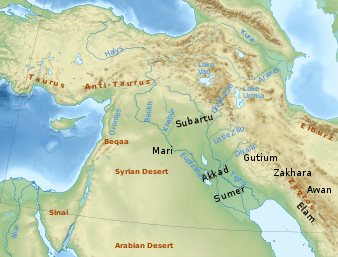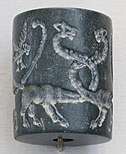Gutian language
Gutian (/ˈɡuːtiən/; also Qutian) is an extinct unclassified language that was spoken by the Gutian people, who briefly ruled over Sumer as the Gutian dynasty in the 22nd century BCE (middle chronology). The Gutians lived in the territory between the Zagros Mountains and the Tigris. Nothing is known about the language except its existence and a list of names of Gutian rulers in the Sumerian King List.
| Gutian | |
|---|---|
| Qutian | |
| Region | Zagros Mountains? |
| Ethnicity | Gutian people |
| Era | Bronze Age (EBA IV) |
| Language codes | |
| ISO 639-3 | None (mis) |
| Glottolog | guti1235 |
 Near East in the 3rd millennium BCE | |
Evidence
Gutian is included in a list of languages spoken in the region found in the Sag B tablet, an educational text from the Middle Babylonian period possibly originating from the city of Emar.[1] This text also lists Akkadian, Amorite, Sutean, "Subarean" (Hurrian) and Elamite. There is also a mention of "an interpreter for the Gutean language" in a tablet from Adab.[2]
The Gutian king names from the Sumerian list are:[3]
Different manuscripts record different Gutian kings in different orders. Some names may be from other groups, and the transmission of the names is unreliable.[4]
Thorkild Jacobsen suggested that the recurring ending -(e)š may have had a grammatical function in Gutian, perhaps as a case marker.[5]
Tocharian theory
In a posthumously-published article, W. B. Henning suggested that the different endings of the king names resembled case endings in the Tocharian languages, a branch of Indo-European known from texts found in the Tarim Basin (in the northwest of modern China) dating from the 6th to 8th centuries CE.[6] Henning also pointed to the phonological similarity of the name Guti to Kuči, the native name of the Tocharian city of Kucha. He also stated that the Chinese name Yuezhi, referring to nomadic pastoralists living in the grasslands to the northeast of the Tarim in the 2nd century BCE, could be reconstructed as Gu(t)-t'i.[6] However, this name is usually reconstructed with an initial *ŋʷ- in Old Chinese.[7] Henning also compared the name of a country called Tukriš, listed with Gutium and other neighbouring countries in an inscription of Hammurabi, with the name twγry found in an Old Turkish manuscript from the early 9th century CE, which is thought to refer to the Tocharians.[6] Gamkrelidze and Ivanov explored Henning's suggestion as possible support for their proposal of an Indo-European Urheimat in the Near East.[8][9] However, most scholars rejected the attempt to compare languages separated by more than two millennia.[10]
References
- Heimpel, Wolfgang (2003). Letters to the King of Mari. Eisenbrauns. p. 13. ISBN 978-1-57506-080-4.
- Wilcke, Claus (2007). Early Ancient Near Eastern Law: A History of Its Beginnings : the Early Dynastic and Sargonic Periods. Eisenbrauns. p. 50. ISBN 978-1-57506-132-0.
- "The Sumerian king list". The Electronic Text Corpus of Sumerian Literature. Faculty of Oriental Studies, University of Oxford. 308–334.
- Michalowski, Piotr (2017). "Ancient Near Eastern and European isolates". In Campbell, Lyle (ed.). Language Isolates. Routledge. pp. 19–58. ISBN 978-1-317-61091-5. p. 37.
- Jacobsen, Thorkild (1973) [1939]. The Sumerian King List (PDF). University of Chicago Press. p. 207, n. 40. ISBN 0-226-62273-8.
- Henning, W.B. (1978). "The first Indo-Europeans in history". In Ulmen, G.L. (ed.). Society and History, Essays in Honour of Karl August Wittfogel. The Hague: Mouton. pp. 215–230. ISBN 978-90-279-7776-2.
- Baxter, William H. (1992). A Handbook of Old Chinese Phonology. Berlin: Mouton de Gruyter. p. 806. ISBN 978-3-11-012324-1.
- Gamkrelidze, T.V.; Ivanov, V.V. (1989). "Первые индоевропейцы на арене истории: прототохары в Передней Азии" [The first Indo-Europeans in history: the proto-Tocharians in the Near East]. Journal of Ancient History (1): 14–39.
- Gamkrelidze, T.V.; Ivanov, V.V. (2013). "Индоевропейская прародина и расселение индоевропейцев: полвека исследований и обсуждений" [Indo-European homeland and migrations: half a century of studies and discussions]. Journal of Language Relationship. 9: 109–136.
- Mallory, J.P.; Mair, Victor H. (2000). The Tarim Mummies. London: Thames & Hudson. pp. 281–282. ISBN 978-0-500-05101-6.
